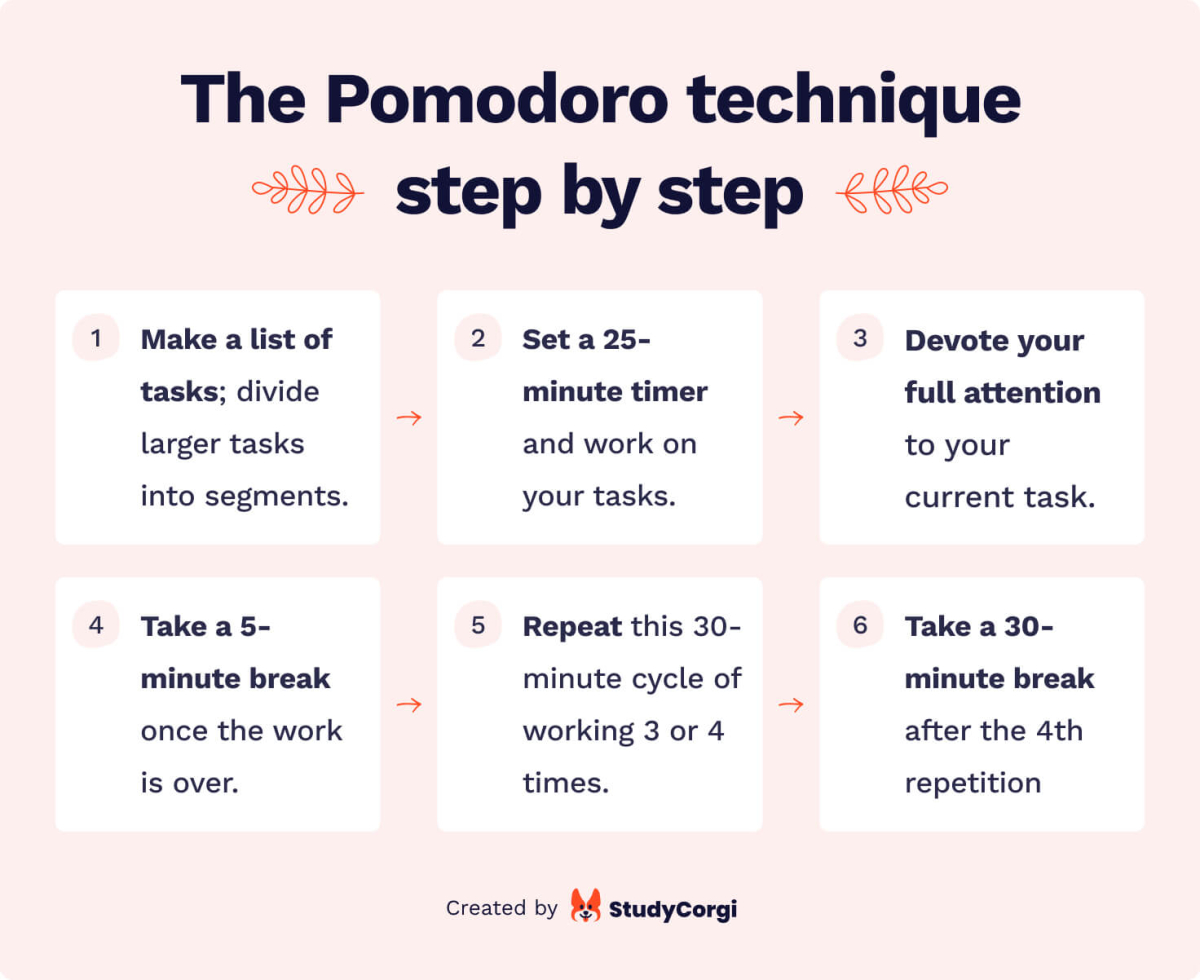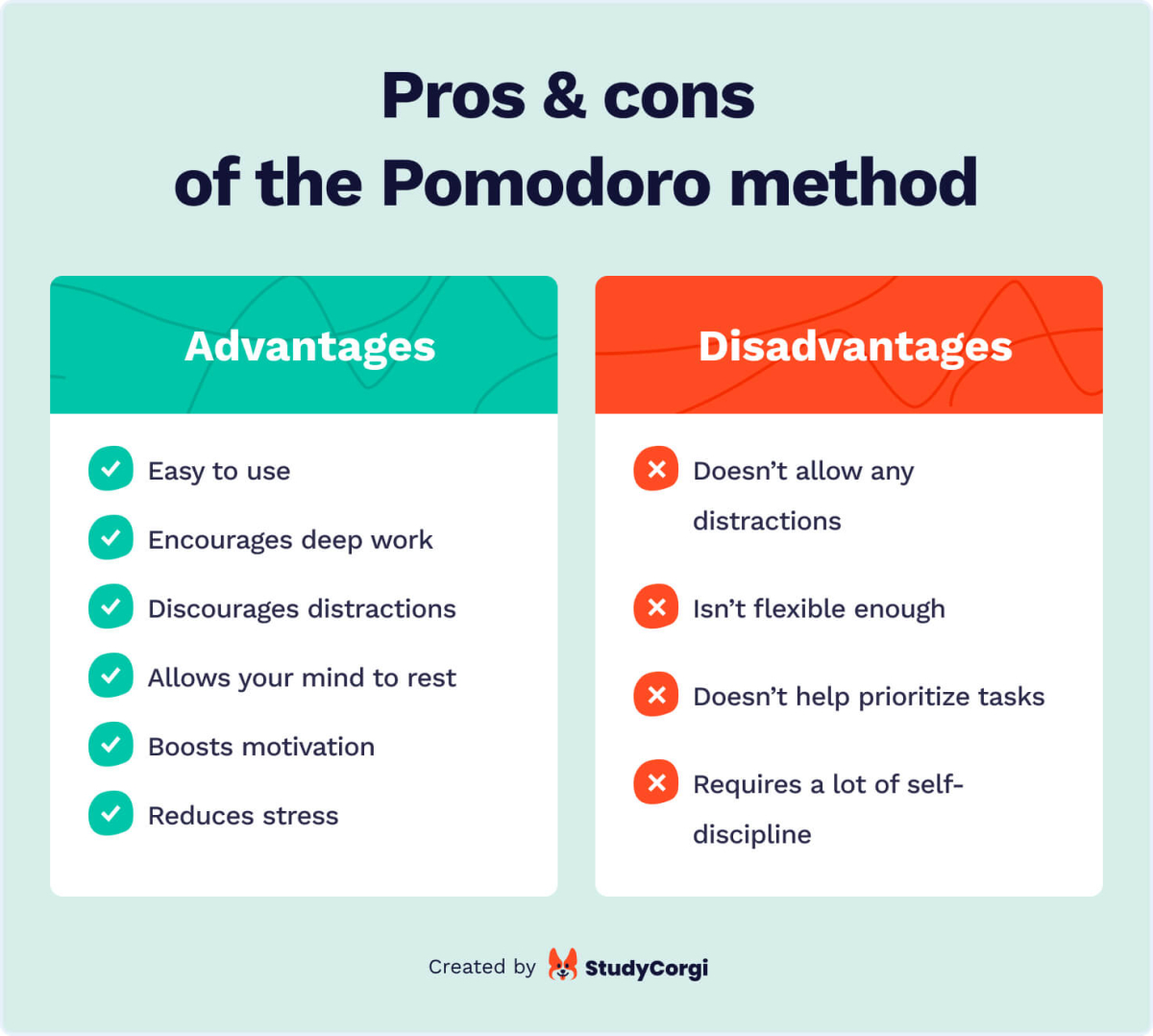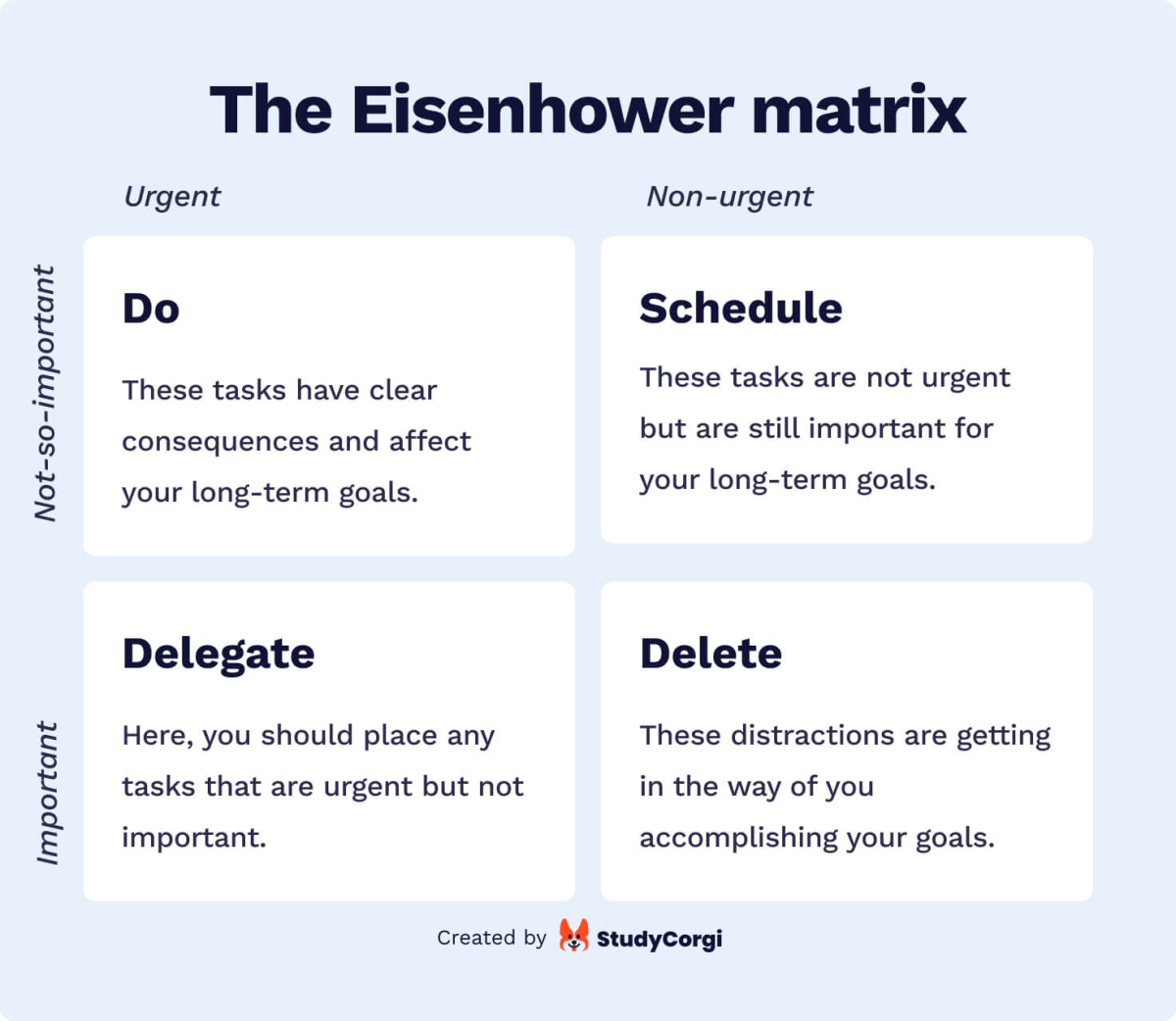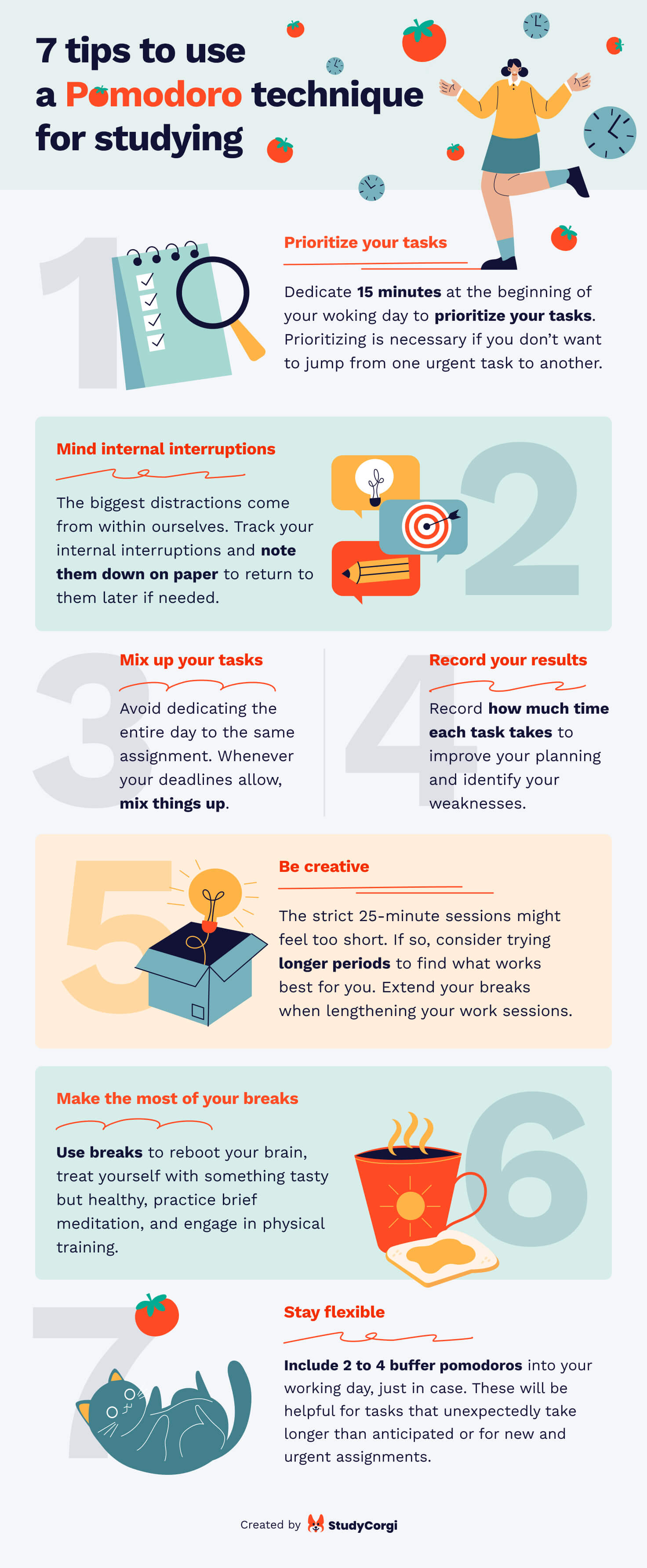Do you often find yourself thinking that tasks take longer than planned, the workload is overwhelming, and everything seems to fall apart?
If so:
The Pomodoro technique might be the perfect solution.

This article delves into the intricacies of this approach, tailored for students and other creative professionals. You’ll gain a comprehensive understanding of its advantages and disadvantages, along with a valuable list of tips to help you incorporate it into your daily routine.
🍅 What Is the Pomodoro Technique?
The Pomodoro Technique is a time-management method that divides available time into 25-minute periods of concentrated work, interspersed with 5-, 15- or 30-minute breaks.
You can easily master this approach with the step-by-step description provided below in just a few minutes.
The Pomodoro Story
It’s a tale of making time your ally, not your enemy.
It was 1987 when Francesco Cirillo was preparing for his sociology exam. He desperately tried to focus, but to no avail.
Finally, Francesco challenged himself to stay focused for at least two minutes. To do so, he grabbed a timer from the kitchen (yes, there were no smartphones with a timer yet).
The experiment worked. He achieved two minutes of utmost focus and then tried for longer periods. Francesco kept increasing the time, discovering that after 25 minutes, his focus started to decrease. But when he followed those 25 minutes with a short break, it worked again!
So why is it called “Pomodoro”? Francesco’s timer device was shaped like a tomato, a “pomodoro” in Italian. The origin of the technique’s name is that simple.
Who Can Benefit Most from the Pomodoro Method?
There are several groups of people who are particularly recommended to use the Pomodoro Method.
Students
Studying can be enjoyable when you’re delving into something you love.
However:
Most of us have to study a wide range of subjects to earn a degree. The need to concentrate on less exciting topics often leads to distractions, procrastination, and other unproductive activities.
Thus, the 25-minute study method helps to maintain focus on the assignments and transforms long hours of late-night studying into a more engaging and manageable experience.
Working Parents of Young Children
Imagine throwing a tennis ball into the air and catching it – it’s relatively easy.
Now:
Imagine throwing two balls simultaneously and trying to catch both at once – it’s not just twice as complicated, but four times. This serves as a metaphor for juggling parenting and work responsibilities.
The Pomodoro technique is essential in helping these individuals distinguish between work and rest periods, minimizing distractions.
People with ADHD
If you have attention-deficit / hyperactivity disorder, you may frequently switch between tasks without completing any of them.
The study method with breaks allows you to accommodate your natural tendency to shift focus while providing sufficient time to get things done.
Easily Distractable People
You might find yourself checking your news feed every five minutes or constantly glued to your phone. Simply promising to stop these behaviors often doesn’t work.
What to do then?
Embrace your tendencies and redirect them effectively.
Dedicate focused time to what matters for a while, then allow yourself to check in on other things for several minutes.
⏰️ The Pomodoro Technique Step by Step
Can’t wait to get down to business? In this section, you will find a simple but detailed step-by-step description of the Pomodoro method. Use it to start being more productive right now!

Here are the 6 steps of the Pomodoro technique:
- Identify the tasks:
- Create a list of short tasks that can be completed within a few hours.
- Whenever possible, divide larger tasks into smaller 25-minute segments.
- Organize the tasks in a logical sequence.
- Visualize the desired outcome.
- Set a 25-minute timer:
- Avoid attempting to keep track of time mentally.
- Using a physical stopwatch is preferable to using your phone, especially if you’re prone to social media distractions.
- Consider placing the timer out of your direct line of sight so that you hear the alarm but don’t constantly monitor the time, which can be distracting.
- Focus on the work:
- Devote your full attention to your current task.
- Move on to the next task only after completing the previous one.
- Avoid multitasking.
- Refrain from playing background music while using the Pomodoro technique for studying.
- Take a 5-minute break:
- During the break, refrain from working, regardless of your level of motivation.
- Physically distance yourself from your previous task.
- Plan how you will spend your breaks in advance.
- Enjoying a cup of tea is always a good option.
- Repeat four times:
- Four repetitions are the most effective.
- Vary the activities during the break.
- Avoid checking your social media during breaks, as it can drain your energy.
- Take a 30-minute break:
- After the fourth repetition, set the timer for 30 minutes.
- Use this time to take a walk or do something you enjoy.
- Consider it a reward for your intensive work.
- Avoid using this time for domestic chores, as it can lead to burnout quickly.
🔬 A Bit of Science Behind the Pomodoro Method
As mentioned earlier, the 25-minute study method was discovered by chance.
However:
Like all effective techniques, it is grounded in a solid scientific background. Here are several studies that should further motivate you to use a timer.
Breaks Improve Your Focus
Researchers from the University of Illinois have confirmed what many of us suspected:
Avoiding breaks impairs your ability to focus.
It’s not that you lack attention; it’s always present. The issue lies in where your attention is directed. You underperform because you can only focus on a single task for a brief period. However, once you switch to something else and then return, you can approach it with a fresh perspective.
Cognitive Boredom and Its Significance
Did you know that researchers are actively studying boredom? This often underestimated emotion significantly impacts our productivity. Boredom reflects our reluctance to interact with our surroundings when we crave stimulation.
Psychologist John Eastwood from York University defines boredom as an “unengaged mind” resulting from “an unfulfilled desire for satisfying activity.”
He found that boredom leads to performance errors.
Furthermore:
Engaging in intensive, uninterrupted work often leads to boredom.
Interviews with ADHD Students
Students with ADHD and other learning disabilities were recommended to try the Pomodoro technique to improve their focus.
Interviews with these individuals confirmed that the 25-minute study method had become a beneficial habit for them.
Their primary issue was the anxiety they experienced before sitting down for extended periods at a desk. However, breaking their work into smaller, more manageable segments helped alleviate this anxiety.
Procrastination & Motivation Vs. Pomodoro
Research was conducted to verify the efficiency of the Pomodoro technique for online learners. The findings indicate that this time-management tool reduces procrastination and enhances motivation.
Still:
The differences observed are relatively minor. The researchers concluded that while improvements are present, they are not insignificant.
Summing up the Research
The Pomodoro technique for studying is a DIY motivational approach. Scientists have tentatively confirmed that it offers more benefits than drawbacks. The only way to know for sure is to try the method yourself. Continue reading to explore the advantages and disadvantages below.
⚖️ Pros & Cons of the Pomodoro Technique
This section focuses on all the positive and negative aspects that the innocent tomato can bring into one’s life. Are you ready to change your habitual modus operandi?
While reading this part, you’ll receive a bonus:
A list of supplementary techniques that enhance the Pomodoro to achieve the most significant results.

6 Benefits of the Pomodoro Method
Given the multitude of research and lifestyle articles on this subject, there is little doubt that the Pomodoro method has its advantages.
Here they are.
Easy to Use
To incorporate this method into your daily routine, you only need two things:
- A timer
- A list of tasks
A timer has been available on any contemporary mobile phone since the early 2000s. Nevertheless, an old-style kitchen timer would work just as well.
There is also a long list of online and downloadable Pomodoro apps (most of which are free).
The second “thing” is the list of tasks, which we are confident you already have.
Other nuances can enhance the tool’s efficiency, but they are primarily related to intelligent planning, prioritization, and result evaluation. We will discuss that below, but you don’t need them to start using the Pomodoro method.
Encourages Deep Work
The Pomodoro technique aligns perfectly with deep work, a state of mind free from distractions. It pushes your capabilities to their limits. While deep work is a general approach to work and life, the Pomodoro technique serves as a tool to implement it.
Cal Newport, the creator of the Deep Work concept, believes that undivided attention is a trainable skill. So, develop a schedule with Pomodoro and enjoy the results!
Discourages Distractions
Your task is simple:
Set the timer for 25 minutes and work as diligently as possible.
Checking emails, making unplanned phone calls, or washing the dishes to procrastinate is a bad habit. Replace it with something more productive. Over time, you’ll notice how natural and easy it becomes to concentrate on one task and then enjoy a well-deserved rest.
Allows Your Mind to Rest
Have you noticed that your best ideas often emerge when your brain is at rest, such as during a shower or before bedtime? Taking five-minute breaks between Pomodoro sessions provides your brain with the opportunity to rest and recharge.
To prevent mental fatigue during these breaks, consider practicing meditation or deep breathing techniques.
In simpler terms, when your mind is constantly bombarded with external stimuli, it becomes challenging to hear your own voice. It’s during moments of quiet and rest that your inner voice can emerge and provide valuable insights.
Boosts Motivation
Boosting motivation is a reliable way to accomplish tasks, and the Pomodoro technique provides two effective strategies:
- Break big tasks into smaller, manageable segments.
- Reward yourself upon completing each segment.
By employing both of these approaches, the 25-minute study method can significantly enhance your motivation, especially when you take time to enjoy your breaks.
Reduces Stress
When deadlines loom large, time can feel like an enemy, leading to stress and anxiety. The Pomodoro technique, however, offers a solution by effectively managing your time and providing a sense of control. As mentioned earlier, time becomes your ally rather than your adversary, reducing stress and enhancing productivity.
4 Drawbacks of the Pomodoro Method
Nothing in this world comes without its drawbacks, and even this seemingly innocent method has its pitfalls. Still, you can eliminate or reduce these drawbacks by using additional techniques described below. Alternatively, you may find that other time-management methods work better for you.
Doesn’t Allow Any Distractions
The classical Pomodoro approach favors your concentration if you follow the rules.
However, the devil is in the details. Unfortunately, not everyone can afford 25 minutes of uninterrupted work.
For instance, work-from-home mothers or managers who receive frequent phone calls may find the routine depressing. After several attempts, they might throw the Pomodoro timer out of the window.
In such cases, you might want to consider time tracking. This method also focuses on managing your time across various tasks and applications, but it provides more flexibility. Keep in mind that you will need special software for this, so be prepared to do some research.
Isn’t Flexible Enough
If you happen to complete the task before the interval elapses, you may find yourself wondering what to do next. In another scenario, you will be anxious if a job takes longer than the sacred 25 minutes. Thus, you will be in a hurry and make mistakes.
If the Pomodoro technique lacks flexibility in your eyes, try time blocking:
- Divide your day into blocks (a colored timetable works best here).
- Each block will stand for a related group of tasks.
- Instead of keeping an open-ended list of things you’ll get to as you can, start each day with a concrete schedule outlining what you’ll work on and when.
With time-blocked days, you won’t constantly make choices regarding what to focus on.
Doesn’t Help Prioritize Tasks
The Pomodoro technique requires a pre-written list of tasks to complete, and it recommends starting with the most urgent and important ones.
However:
Determining which tasks fall into these categories can be challenging. The issue is particularly crucial for individuals with ADHD, as they may perceive all tasks as urgent. In such cases, the Pomodoro may not be as effective, as its goals differ from those with ADHD.
To address this challenge, you can complement the Pomodoro method with the Eisenhower Matrix.
This matrix is highly effective for tasks of any scale, whether it’s day-to-day planning or setting lifelong goals. You can use the table below to categorize your tasks before you start the timer.

Takes a Lot of Discipline
Implementing the Pomodoro technique for ten to twelve sessions a day requires a significant amount of self-discipline, which many of us struggle with. It’s important to acknowledge that building this level of discipline takes time. However, like any habit, it eventually becomes second nature.
To make the transition smoother, you can try Eat the Frog (not literally, of course, as no frogs should suffer in the process).
Here’s how it works:
- Identify the most challenging and least enjoyable task, which is usually the most urgent and important task. Consider this your “frog.”
- Focus on tackling this task with as much concentration as you can, and use the Pomodoro technique to help you stay on track.
- Make it a habit to start your day by “eating the frog.”
The idea is to start the day with the hardest task, making the rest of the day seem like a piece of cake for you.
🧑🎓️ 7 Tips to Effectively Use the Pomodoro Technique for Studying
While this article can be helpful for anyone interested in self-management, it is primarily intended for students. Therefore, the tips provided below are tailored to fit best into a student’s life.

1. Prioritize Your Tasks
Effective time planning is crucial to maximize the benefits of this study technique. We recommend dedicating about 15 minutes, perhaps during your morning coffee break, to prioritize your tasks.
Prioritizing is necessary if you don’t want to jump from one urgent task to another. For example, your list may look something like this:
- Complete a term paper draft due in two months.
- Write an essay for the Sociology class, which is due in three days.
- Prepare for tomorrow’s exam.
- Cook some food.
- Talk to the plumber about the leaking pipe in the bathroom.
- Check emails, Messenger, and WhatsApp.
While most people’s to-do lists are typically longer, this example demonstrates the general philosophy.
Let’s break it down into the Eisenhower matrix:
- Task 1 is too big to complete in a single day. How can you fit it into a 25-minute session? Break it into smaller parts. You can do this by breaking it into stages of work (such as introduction, chapter 1, chapter 2, findings, etc.) or by pages. Since it falls in the top right corner of the Eisenhower Matrix, you need to plan your activities. Calculate the number of days left before the deadline and distribute the workload evenly, leaving some extra time to account for unforeseen issues.
- Tasks 2, 3, and 5 are all categorized as urgent and important (top left corner). However, the exam is tomorrow, the essay is due in three days, and the pipe is leaking now. Call the plumber right away (while creating your plan), reserve this evening for studying, and use the other two days for the essay. We tend to procrastinate when it comes to phone calls, although they take little time and can prevent many complications.
- Task 4 can be urgent but not as important. If you have too many plans already, you can ask a roommate to handle it today. Alternatively, you can dine out or order food delivery. All of these solutions fall into the “delegate” section of the Eisenhower matrix.
- Task 6 is neither urgent nor important, so you can put it off until you have some free time.
2. Mind Internal Interruptions
During a Pomodoro session, it’s crucial to put away all your gadgets and focus on what needs to be done. However, often, the biggest distractions come from within ourselves. How can you manage that inner urge to do something unrelated to the task you’re working on?
Imagine you are writing an essay on the life of dinosaurs, and you come across an intriguing article about archaeological excavations. It has no direct relevance to your assignment but is too captivating to resist.
The Pomodoro technique’s creator recommends dealing with such urges by tracking them and noting them down on paper.
This approach allows you to:
- Identify tasks that are challenging to focus on and plan them as your “morning frog.”
- Return to the distracting thoughts later, after your Pomodoro session.
- Maintain a list of everything that crosses your mind, which can be a valuable practice.
3. Mix up Your Tasks
Researchers from the University of Southern California have found that task diversity can significantly boost your creativity.
You should avoid dedicating the entire day to the same assignment. Whenever your deadlines allow, mix things up.
For instance:
If you have both an essay and a reading task, allocate one Pomodoro session to each, and then change the order.
Attempting to mix both tasks within a single 25-minute session is not recommended and may not be a good idea.
4. Record Your Results
While many descriptions of the Pomodoro technique overlook this stage, it receives considerable attention in the author’s guide (refer to the “Recording” section).
What should you track here? It depends on your specific goals.
The most evident thing would be to record how much time each task takes. This will help you improve your planning and identify your weaknesses.
5. Be Creative
Individuals who code or write often cherish periods of creative “flow.” The strict 25-minute sessions might feel too short for them, frequently interrupting the creative cycle. Consider trying longer periods to find what works best for you. Also, remember to extend your breaks when lengthening your work sessions.
6. Make the Most of Your Breaks
Breaks are an intrinsic part of the technique. Use them to:
- Reboot your brain (if you work at a laptop, leave it in peace for five minutes).
- Self-reward (treat yourself with something tasty but healthy).
- Practice brief meditation or breathing exercises.
- Engage in physical training.
7. Stay Flexible
An 8-hour workday typically accommodates sixteen pomodoro sessions.
However:
We recommend including 2 to 4 buffer pomodoros, just in case. These will be helpful for tasks that unexpectedly take longer than anticipated or for new and urgent assignments.
If not used for such purposes, keep them for tackling less urgent tasks that you’ve been consistently postponing. In the end, it is less stressful to end a day with unused pomodoros than incomplete tasks.
Thank you for reading!
This article has covered most of the pros and cons of the Pomodoro technique. If you have something to add or would like to share your experience implementing the method, please share your thoughts in the comments below. Good luck with your planning and checking all of your tasks off of your to-do list!
